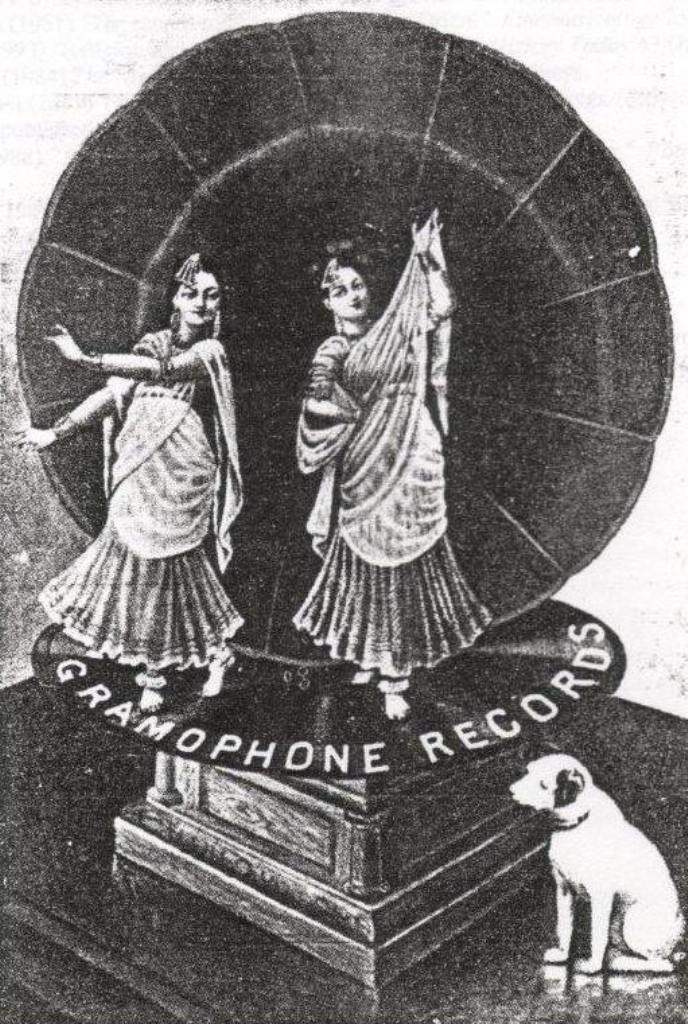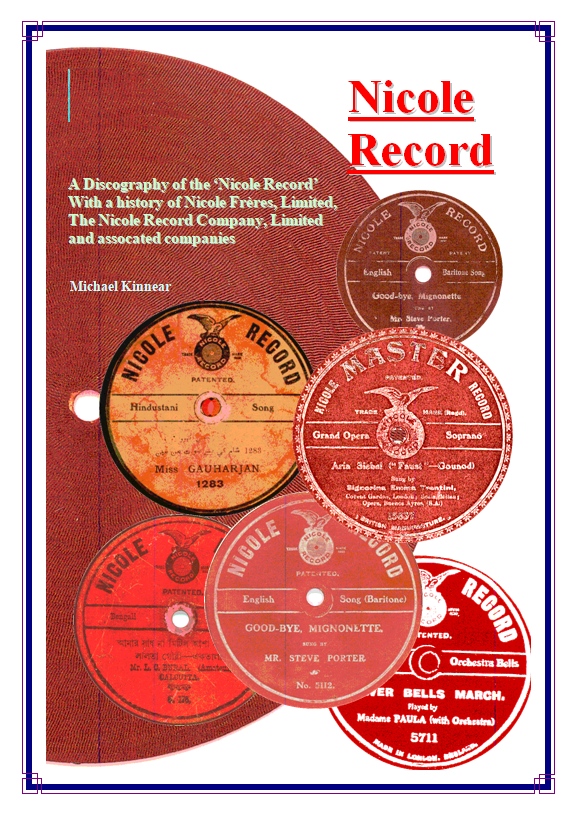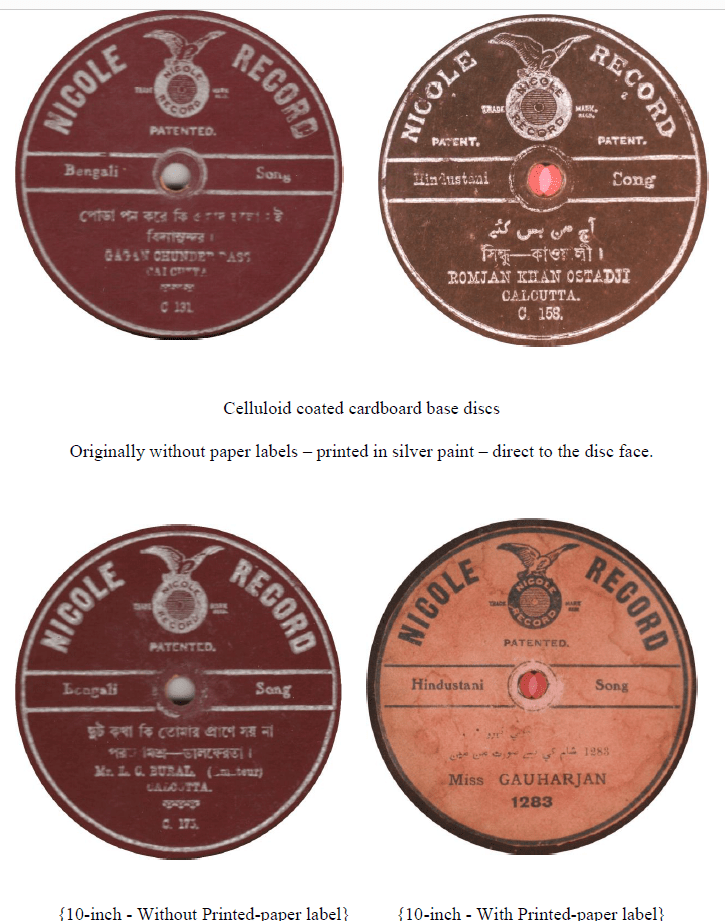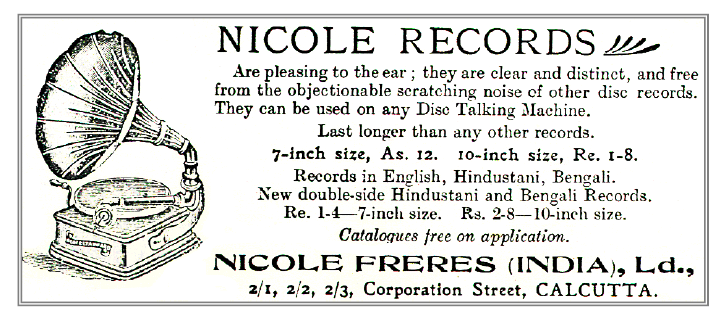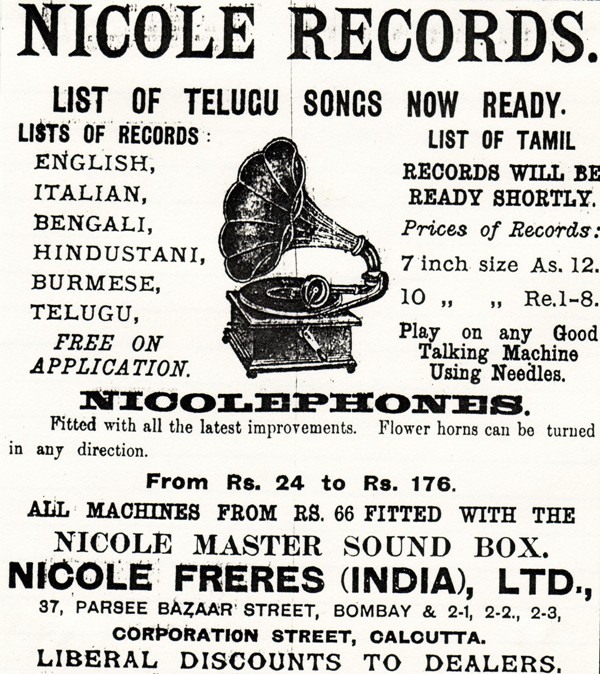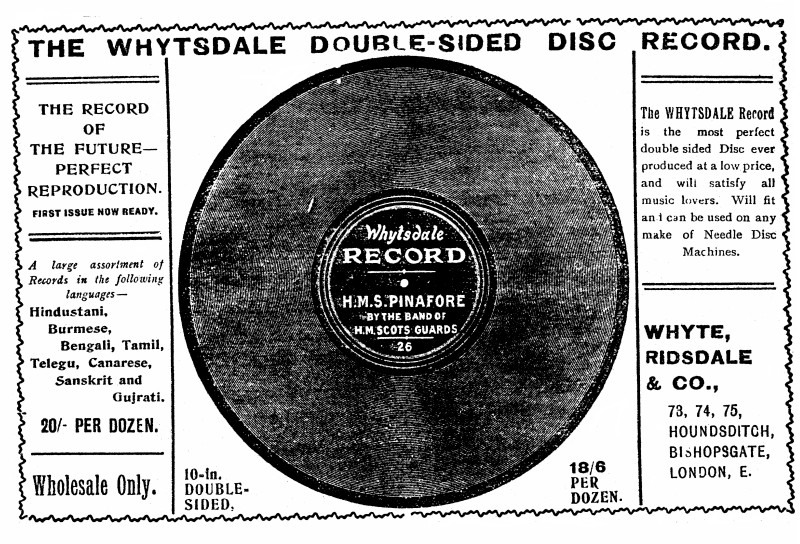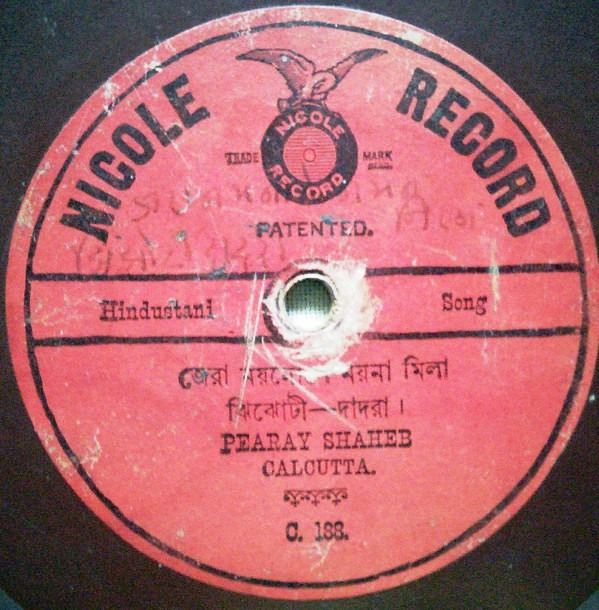NICOLE RECORD
A Discography of the Nicole Record & History
Author: Michael Kinnear
Digital Download Book
AUD $25.00
A discography of the ‘Nicole Record’. With a history of Nicole Frères, Limited, and The Nicole Record Company, Limited, and associated companies. (A numerical listing of all known recordings produced by The Nicole Record Company, Limited, from 1903 to 1906. Together with information about reissued and transferred recordings.) With Bibliography and indices and with illustrations in the text.
Product Details
♦ Published Independently: Michael Kinnear – Bajakhana
♦ Language: English
♦ Pages: 20+288 pages,
♦ Digital Download Book: Published 20th June, 2021
♦ ISBN-10: 0-6456719-2-4
♦ ISBN-13: 978-0-6456719-2-6
‘NICOLE RECORD’
READING INDIAN RECORD LABELS – Part 2
Author: Michael Kinnear
Nicole Frères, Limited, London
Proprietor:
Nicole Frères, Ltd., 21 Ely Place, Holborn Circus, London Nicole Frères (India) Ltd., 21 Ely Place, Holborn Circus, London
Nicole Frères (India) Ltd., 36 Walbrook, London
Branch Office:
Nicole Frères, Ltd., 3-4 Council House Street, Calcutta
Nicole Frères (India) Ltd., 2-1,2,3 Corporation Street, Calcutta
Nicole Frères (India) Ltd., 37 Parsi Bazar Street, Fort, Bombay
Agents:
Atmaram, MacLean and Co., 37 Parsi Bazar Street, Fort Bombay
Manufacturer:
The Nicole Record Co., Ltd., Great Saffron Street, London
The Disc Record Co., Ltd., Wellington Mills, Stockport, England *
Series: (Numerical) (Brown) [celluloid coated cardboard] [NICOLE]
C- numerical (Brown) [celluloid coated cardboard]
C- numerical (Red) [black shell
C- numerical (Green)
C-462 to 469 {Red} [Reported pressed as “National Record”]
Nicole Frères was established in 1815 at Geneva, Switzerland as music box makers. In the early 1890’s the business was re-located to London, and in 1897, converted into a limited liability company, in the name of Nicole Frères, Ltd., 21 Ely Place, London. Nicole Frères, Ltd., was amongst the earliest traders of talking machines in England, handling Edison and ‘Zon-o-phone’ machines.
Nicole Frères (India) Limited, London
To handle the business in India a separate company had been established also located at 21 Ely Place, London in the name of Nicole Frères (India) Ltd., by the Chairman of the parent company, Thomas Clement Usher. In March 1906, Nicole Frères, Ltd., was forced into voluntary liquidation, which also forced The Nicole Record Co., Ltd., into closure, although the failure of the parent and manufacturing companies did not directly effect Nicole Frères (India) Ltd., or its operations in India.
The ‘NICOLE RECORD’ is amongst the rarest of record labels with an Indian repertoire, and with it’s introduction to the disc record market in India by mid-1905, this – brown, celluloid coated, cardboard disc record – was only the second disc record label to feature a repertoire of Indian recording artists, the first being the ‘Gramophone’ records.
Attempts to establish a record factory to produce the ‘NICOLE RECORD’ were begun in mid-1902 by Nicole Frères, Ltd., one of the foremost musical box makers, who had originally begun it’s business in Geneva in 1815.
The steady decline in sales of musical boxes at the turn of the century, had led Nicole Frères, Ltd,, to take a keener interest in the ‘talking machine’ trade, which then led to the company being interested in entering this burgeoning industry as a manufacturer of disc records. The impetus for Nicole Frères, Ltd., to enter the ‘talking machine’ industry as manufacturers developed out of their involvement with the International Zonophone Company, of Berlin, who were – at that stage -still an independent company, and not associated with The Gramophone & Typewriter, Ltd.
Nicole Frères, Ltd., as the sole agents for ‘Zonophone’ products in Great Britain, were having difficulties meeting the demand for disc records to play on ‘Zonophone’ machines, and so entered into negotiations with the International Zonophone Company to set up a disc record factory to ensure a constant supply of ‘Zonopbone’ disc records for the English market.
This proposal soon floundered because while Nicole Frères, Ltd., was in the process of perfecting their own disc record, The Gramophone & Typewriter, Ltd., acquired the controlling interest in the International Zonophone Company – thus eliminating that company as competitor. Nicole Frères, Ltd., were then forced to carry on separately and by August 1903 had issued the first releases on their own ‘NICOLE RECORD’ label.
 Nicole Record, L.C. Bural. C.175 and C.176
Nicole Record, L.C. Bural. C.175 and C.176
Michael Kinnear Collection
The first manager of The Gramophone & Typewriter, Ltd., branch office at Calcutta, John Watson Hawd, had returned to England in July 1903, and was quite disgruntled with the way the Indian branch was being treated. John Watson Hawd resigned from The Gramophone & Typewriter, Ltd., and after a few months re-emerged as one of the directors of the newly formed Nicole Record Co., Ltd.
By late 1904, John Watson Hawd had returned to Calcutta with Stephen Carl Porter – The Nicole Record Co., Ltd’s recording expert to begin recording a repertoire of Indian music. After establishing wholesale and retail outlets for the forthcoming ‘NICOLE RECORD’ releases, Hawd left Stephen Porter to carry on with the recording program alone.
 After taking some two hundred recordings at Calcutta, Stephen Porter moved onto Madras where further recordings were taken. Some more recordings were taken at Bombay, before Stephen Porter returned to Calcutta. Some Burmese recordings were taken at Rangoon before Stephen Porter completed his recording tour by March 1905.
After taking some two hundred recordings at Calcutta, Stephen Porter moved onto Madras where further recordings were taken. Some more recordings were taken at Bombay, before Stephen Porter returned to Calcutta. Some Burmese recordings were taken at Rangoon before Stephen Porter completed his recording tour by March 1905.
This recording tour by Stephen Porter on behalf of The Nicole Record Co., Ltd,, produced about seven hundred recordings of Indian songs and tunes in Bengali, Hindustani, Gujarati, Canarese, Tamil and Telugu, along with recordings in Burmese.
 Nicole Record, Steve Porter, 7″ No. 650, 9 3/4″ No. 5112
Nicole Record, Steve Porter, 7″ No. 650, 9 3/4″ No. 5112
Michael Kinnear Collection
By September 1905, the first releases on the ‘NICOLE RECORD’ label were on the market in India. M. L. Shaw, of 23/5 Dharamtala Street, was the first wholesale agent to distribute the ‘NICOLE RECORD’ in India. In Madras, M, Tara & Co., 6 Broadway, was appointed the agent for Southern India.
In March 1906, Nicole Frères, Ltd., was forced into voluntary liquidation by the legal action of its Chairman, Thomas Usher who was also the controller of its Indian branch, Nicole Frères (India) Ltd., which operated as a separate company under Usher’s directive.
This action closed the businesses of NicoleFrères, Ltd., and The Nicole Record Co., Ltd. but not that of Nicole Frères (India) Ltd., which continued to operate out of its registered office in London. The plant, machinery and matrices of The Nicole Record Co., Ltd,, were sold by its receiver to John Watson Hawd, who had recently resigned from The Nicole Record Co., Ltd., and set up a new company in the name of The Disc Record Co., Ltd., at Stockport, in Northern England, which continued to supply the pressings of the Indian repertoire of the ‘NICOLE RECORD’ for India at least up until late 1908.
During 1908, Nicole Frères (India) Ltd., had re-located its main office in India from 2-1/2/3 Corporation Street, Calcutta, to 35 Parsi Bazar Street, Fort, Bombay, but by this time the ‘NICOLE RECORD’ had been subjected to so many legal changes that it’s ability to supply pressing to the Indian disc record market had become a losing concern. By early 1910, what stocks remained with Nicole Frères (India) Ltd., in Bombay, were sold off to the company’s Bombay manager, James MacLean, who continued on in the industry under the name of Maclean, Atmaram & Co., but within a year this concern had also folded – bringing to an end the marketing of the ‘NICOLE RECORD’ in India.
CATALOGUE and MATRIX NUMBERS
To begin with the brown, celluloid coated, cardboard disc of The Nicole Record Co., Ltd., did not have paper labels – the titles were printed in silver – directly to the centre of the discs – which were available in 7″ and 10″ sizes – and shared a continuous numerical sequence – prefixed by the series letter C-. with both sizes being mixed into the common C-series, beginning at C-1.
From its introduction in August 1903 up to October 1905 all ‘NICOLE RECORD’ releases were single-side recorded discs only. The reverse side of these discs has a ‘rough-back’ – something like the surface of a metal file – to prevent the disc from slipping on the turn-table. During 1904, the words Use Nicole Needles with Nicole Records – in a three inch diameter circle, were added to warn the user that use of any hard steel needle might damage the playing surface of the disc.
As with all ‘Gramophone’ disc records of this period – only catalogue are printed on the label face of the disc. The matrix number is found by examining the disc surface – near the finish of the grooves – remembering that the early ‘NICOLE RECORD’ had no paper label. The actual sequence of matrix numbers of the Indian repertoire of the ‘NICOLE RECORD’ has, as yet not been properly determined or de-cyphered, but the matrix numbers are known to run from C- – with an ‘x, xx, or xxx, or y’ suffix. Whether this refers to the first, second or third recording of the song or tune has not been verified – but it would be fairly safe to presume that this is what the ‘x and y’ suffixes refer to.
To add confusion to the reading of ‘NICOLE RECORD’ labels, both the matrix and catalogue numbers are pre-fixed C-, but most often these numbers to not correspond with each other – so both the catalogue and matrix numbers must be read and noted separately.
From October 1905 – the ‘NICOLE RECORD’ was issued with red paper labels, and was available in both single-side and double-sided discs, thus the same recording which may be found – without a paper label – may also be found with a black printed – red label.
The Disc Record Co., Ltd., of Stockport are known to have used the Nicole matrix stocks for a number of other ‘labels’ including – EMPIRE RECORD. SOVEREIGN, ROYAL RECORD, THE REX RECORD, and several other “tally-man” labels that circulated in England between 1908 and 1915. The Swedish repertoire on ‘NICOLE RECORD’ was pressed as a regular shellac type of disc, but no examples of the Indian repertoire are known to have been re-pressed as shellac discs.
In November 1908, Whyte Ridsdale & Co., of Houndsditch, London, were offering an Indian repertoire of 10″ inch discs on their ‘WHYTESDALE’ label. This disc is known to have been manufactured by The Disc Record Co., Ltd., using Nicole matrices, but no examples of an Indian song or tune have been found on the ‘WHYTESDALE’ label, to verify if in fact these were re-issues of Indian Nicoles.
Although the details of the artists and song tiles are known of about half of the six hundred plus recordings issued on the ‘NICOLE RECORD’ there is still more research required to complete a listing of ‘NICOLE RECORD’ disc records of its Indian repertoire.
The ‘NICOLE RECORD’ is not very often found today – and despite the fact that it was unbreakable (being made of celluloid coated cardboard) – as distinct from the usual •shellac’ variety of nearly all other brand names, the ‘NICOLE RECORD’ was subject to warpage under heat and also to the ravages of termites (pin-holes) and tearing of the playing surface – by use of the wrong needle.
Although the ‘NICOLE RECORD’ is not held in high esteem by most record collectors, there are many Indian recording artists who made their first -disc recordings – for the Nicole label, including Talim Hussain the Sanai player, Monjuddin Khan, Peara Saheb, Baku Babu and others. The ‘NICOLE RECORD’ was the first to issue the song “Bande Mataram” on disc record along with other “national songs” during the height of the ”Swadeshi Movement” between 1905 and 1908, Lal Chand Bural made some thirty recordings for the Nicole label, repeating some songs that he had already recorded for the “gramophone”.
An unusual ‘NICOLE RECORD’ is that of Miss Gauhar Jan under number 1283 (matrix – 1283.C-l) – which does not conform to the ordinary sequence of catalogue numbers. The reverse side of this disc has Pearey Shaheb (sic) under number C-188 (matrix – C-319-x).
There may be other recordings of Miss Gauhar Jan and other famous singers and instrumentalists on the ‘NICOLE RECORD’ label which have still to be traced, and although there are only in the vicinity of six hundred recordings in the Indian repertoire on this label – which survived for less than five years, the ‘NICOLE RECORD’ is very collectable and contains many treasures – from both the artistic and historical perspectives.
For more information on the below Recording Experts mentioned in this ‘Article’ – visit the website of: Hugo STRÖTBAUM – Recording Pioneers
John Watson Hawd
http://www.recordingpioneers.com/RP_HAWD1.html
Stephen Carl Porter
http://www.recordingpioneers.com/RP_PORTER1.html


